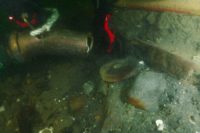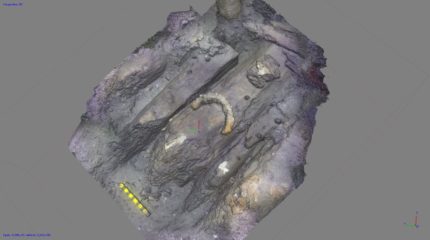Its identity has yet to be conclusively determined, but a shipwreck in Newport Harbor, Rhode Island, is a good candidate for Captain James Cook’s famous ship, the HMS Endeavour. The Rhode Island Marine Archaeology Project (RIMAP) in collaboration with the Australian National Maritime Museum (ANMM) have been exploring the shipwreck this summer. The exposed timbers have been 3D-scanned and some artifacts recovered.
The Endeavour is best known as the ship commanded by Cook on the first voyage to the Pacific (1768-1771) during which he circumnavigated New Zealand and traveled the eastern coastline of Australia, making the first known European contact with indigenous Australians. Endeavour paid a high price for her Australian jaunt, running aground on the treacherous shoals of the Great Barrier Reef and needing extensive repairs.
While her captain became an instant celebrity upon his return, Endeavour toiled in obscurity, first on a Falklands run and then, after being sold to private owners, as a troop transport for British soldiers and prison ship in the Revolutionary War. Just seven years after her return from her epic three-year Pacific voyage, Endeavour was scuttled in the British attempt to blockade Narragansett Bay and prevent a French naval assault.
The exact location of the wreck was not recorded in 1778 and its very identity was lost because the ship had been renamed to the Lord Sandwich when it was sold. RIMAP divers recorded the presence of the wreck in 1993, but it was only known as one of at least 13 ships scuttled by the British. In 1999, researchers discovered that the Lord Sandwich was the Endeavour.
 The latest excavation has been able to confirm that the latest candidate for the wreck of the Endeavour does date to the 18th century. Divers retrieved sheaves from the rigging, wood fragments, leather, textiles, glass, pottery, coal, charcoal, ballast stones and gun flints. The team was able to expose a section of the ship’s structure sufficient to confirm that the timbers are similar in size and arrangement to those know to have been used on the Endeavour.
The latest excavation has been able to confirm that the latest candidate for the wreck of the Endeavour does date to the 18th century. Divers retrieved sheaves from the rigging, wood fragments, leather, textiles, glass, pottery, coal, charcoal, ballast stones and gun flints. The team was able to expose a section of the ship’s structure sufficient to confirm that the timbers are similar in size and arrangement to those know to have been used on the Endeavour.
Principal investigator Kathy Abbass, of the Rhode Island Marine Archaeology Project (RIMAP), said the positive identification of the wreck would probably depend on several things, rather than a single archaeological find.
“We do not think we are going to find something that says ‘Captain Cook slept here’ — that is not likely,” Abbass told Live Science. “But if we find some of the smaller stuff that is consistent with how we know she was used — as a transport and as a prison ship in Newport, then we know we have got her.”
Abbass said archaeologists were focusing on the construction of wreck’s wooden hull and traces of its later uses in the hope of confirming its identity as Cook’s Endeavour.
“We can be excited about the fact that things look promising,” she said, “[but] we are not saying yet that it is her, it just looks very likely that it could be,” she said.
The excavation did find a definitive answer to the question of how the ships were scuttled. The commonly-held belief was that holes were cut in the bottom of the hull and the ships sank. For the first time, divers did discover a hole in the hull near the keel, proving that cut holes were indeed used to sink the ships. They were random holes, indiscriminate destruction, but carefully positioned to sink the ships as efficiently as possible.

That’s the weirdest folding rule I’ve ever seen. Who designed it, and what was he or she thinking!?
Made in England and, rather disturbingly, it uses “inches”. Designed in 1784: That weird folding rule is Capt. Cook’s, actually!!! :boogie:
The use of the imperial system is way less-disturbing than the articulation of the rule at 9 7/8″, 19 11/16″, and 29 9/16″!
The Captain wouldn’t have been seen dead with it.
That rule is a standard design, long used in woodworking and building work in Britain. My father and both my grandfathers had such ones, generally 2 feet long, folding on the 6 inch points. This one is a venerable Rabone Chesterman Tufrule no. 1304, and is just over 39 inches long because the other side is metric, and is designed to be a metre long. I see it is made of nylon, rather than the traditional boxwood(?), which would make it better for use under the sea…